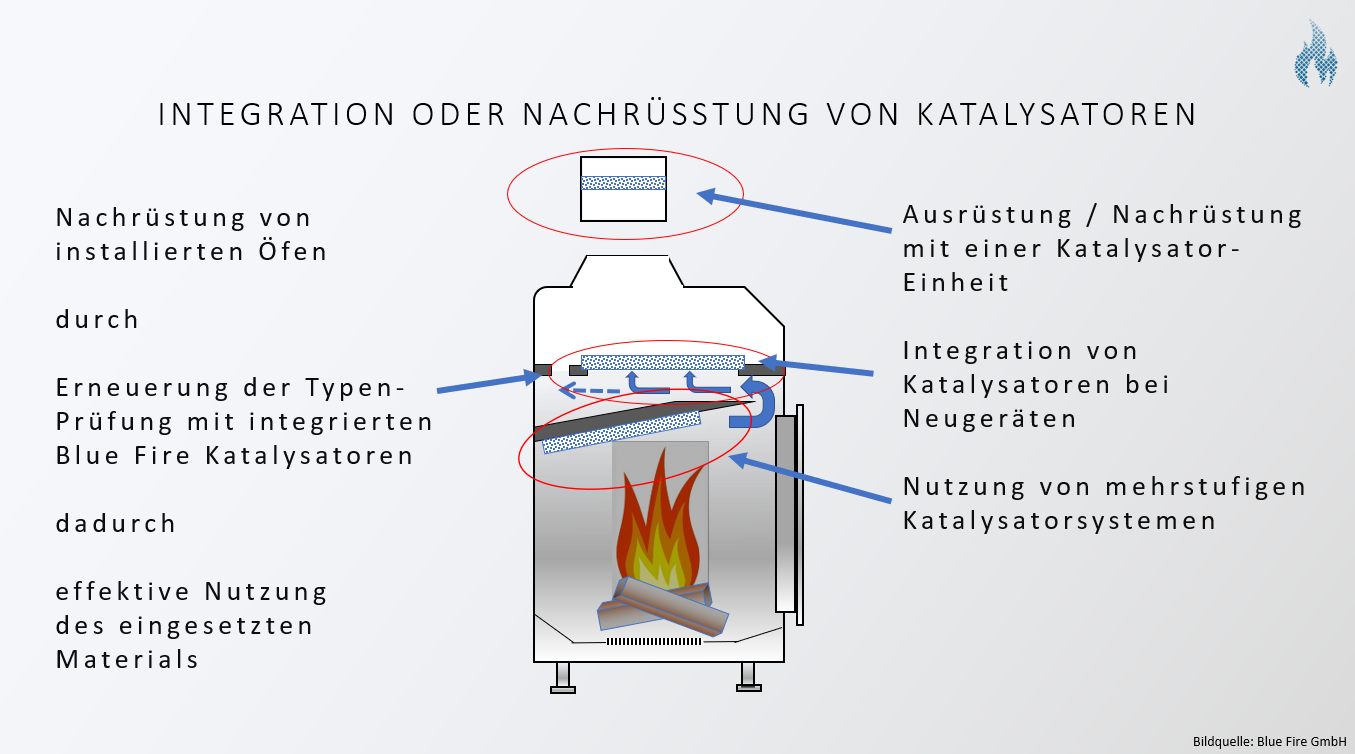
Blue Fire: Project reduces dust from wood fires
22. July 2021
Emission reduction in wood firing systems – Types of catalysts, their installation and mode of operation
22. July 2021
Your single room combustion system has reached the replacement deadline of the 1st BImSchV and you have been informed by your chimney sweep when the combustion system is to be replaced or retrofitted. From this point on, every operator of a combustion system is faced with the question: Replace and buy new or retrofit? The operator weighs up the costs of replacement versus retrofitting.
The most sensible way to approach the issue of replacement or retrofitting is by looking at the type of wood-burning appliance.
Wood-burning stoves are single-room furnaces that can be freely placed in the room where they are installed. They are, if one may paraphrase, pieces of furniture in which a fire can be made and with which a comfortable warmth is quickly achieved in the installation room. Stoves are connected to the chimney via an exhaust pipe. They are operated both room-air-dependent and room-air-independent. The combustion chamber is designed in such a way that it is sufficient to burn for approx. 45 minutes. After that, the combustion chamber must be reloaded with wood. The user must regularly refill the stove with new firewood if he wants to enjoy the warmth for a longer period of time.
Fireplace inserts are also defined as single-room fireplaces, which are, however, usually firmly connected to the installation room by a specially designed casing/enclosure. The fireplace itself is a combustion chamber made of steel, including air ducting and usually elaborate glazing. This fireplace insert is either fitted with a system cladding from the manufacturer or with a cladding/enclosure designed by the stove builder. These claddings are often connected to the wall or walls of the installation room. The same applies to tiled stove inserts. These are connected to the room where the stove is installed, or to several rooms at the same time, in a much more elaborate way due to the draught system adjacent to the heating insert. Like fireplace inserts, basic stoves are provided with an enclosure/cladding. However, these are characterised by a large storage mass, which transfers the heat very evenly to the installation room over a long period of time.
Following the previous explanation, wood-burning stoves are more mobile single-room furnaces than fireplace inserts, tiled stoves, ground stoves and the like. The latter are rather immobile. Stoves could therefore be relatively easily exchanged for a new one when the replacement period is reached. Nevertheless, wood-burning stoves are also products with a certain weight, which makes it necessary to transport them in and out using a hand truck. The replacement means that the flue pipes have to be dismantled and adjusted, and the accumulation of dirt in the installation room must also be expected in such a case of replacement.
Compared to stoves, however, immobile fireplaces pose a challenge for replacement.
If you want to replace the fireplace insert, this is not easy. The enclosures / linings have been individually adapted to the needs of the fireplace insert and the customer. In most cases, the elaborately constructed casing / cladding must be dismantled or even completely removed for replacement. It is also possible that the casing / enclosure will be destroyed in the process.
With tiled stove inserts, it is much easier to replace the combustion chamber. These combustion chambers are designed and manufactured in a uniform size grid. The tiled stove inserts can often be pulled out of the masonry stove on a rail system and easily replaced in this way.
When retrofitting, a distinction must be made between two different types. On the one hand, firing systems can be retrofitted with catalytic converters directly in the combustion chamber and, on the other hand, retrofitting takes place after the exhaust gas connection outside the firing system, i.e. externally.
Retrofitting in the combustion chamber is also called integrated retrofitting. For this purpose, the ideal position for the catalytic converters and the bypass is determined for the respective firing in the combustion chamber. The company ETE EmTechEngineering GmbH specialises in such services. A support system is designed in which the bypass is directly integrated. The holding system with the catalytic converters used is inserted into the combustion chamber. The furnace retrofitted in such an integrated way must then be subjected to a new type test by the furnace manufacturer, in which the improved emission measurements are assigned to the old furnace. This procedure must be carried out once by the manufacturer of the combustion system for the respective type of combustion system. Once the renewed type test has been carried out, the catalytic converter retrofit kit integrated into the combustion chamber is approved and may be placed on the market by the combustion system manufacturer. Such retrofit systems usually even have to be installed in the combustion chamber by the operator. During the development of this integrated retrofit, great importance is attached to easy installation and removal. Before starting the integrated retrofit, the operator should consult the responsible chimney sweep. The combustion system must be inspected by the chimney sweep before retrofitting can be permitted. This involves checking whether walls in contact with fire still have the minimum wall thickness and whether the technical condition of the furnace is suitable for further years. If this has been confirmed by the chimney sweep, the integrated retrofit kit can simply be ordered from the furnace manufacturer and installed in the combustion chamber. After installation, the chimney sweep must be informed of the retrofit so that he can enter the retrofit in the sweep book and approve the continued use of the retrofitted combustion system.
In the case of elaborately clad / enclosed fireplace inserts, the integrated option for retrofitting is the simplest and cleanest, as it takes place directly in the combustion chamber, which is always easily accessible from the installation room. If inspection openings for cleaning the flue pipe are provided in the casing / enclosure, then an external retrofit with catalytic converters can also take place.
To do this, the exhaust pipe is removed from the exhaust connector and a retrofit catalytic converter is placed on the exhaust connector. The exhaust pipe must then be readjusted in length.
Such external retrofit catalytic converters must have their own type approval, as they must function universally on different furnaces. However, there are no approval specifications for retrofit catalytic converters in Germany. Retrofitting is only intended for dust collectors. Therefore, external retrofits can currently only be approved as dust collectors. A standard for mechanical retrofit dust collectors is being developed. Therefore, such retrofit solutions are currently being tested for approval by the Deutsches Institut für Bautechnik (DIBt). These retrofit dust separators must prove a dust separation of at least 30% in the approval test. CO and OGC emissions do not play a role in the approval for retrofit dust separators.
Retrofit catalytic converters integrated into the combustion chamber are very good at reducing CO and OGC emissions because the retrofit catalytic converters are integrated into the combustion chamber where the emissions occur. The ambient temperatures in the combustion chamber ensure a rapid light-off of the catalytic converters and thus guarantee high reduction rates of the above-mentioned CO and OGC emissions after only a short time.
If a multi-stage catalytic converter system consisting of a stage 1 and a stage 2 catalytic converter is integrated into the combustion chamber, the emissions can be reduced in a very targeted and separate manner. The stage 1 catalytic converter sits directly under the flame impingement plate in the combustion chamber and separates dust. It also ensures an initial CO reduction at still high temperatures. The dust separated here no longer reaches the stage 2 catalytic converter and does not block its active surface. The stage 2 catalytic converter is positioned behind the flame baffle, after the 180° deflection of the exhaust gases. This reduces the flow velocity and increases the residence time of the exhaust gases in the stage 2 catalyst. The main CO and OGC reduction takes place in the stage 2 catalytic converter. The exhaust gas temperatures there have already cooled down, but they are ideal exhaust gas temperatures for the catalytic converter. Without a stage 2 catalytic converter, the CO and OGC emissions would no longer be able to combine with oxygen.
In summary, retrofit catalytic converters integrated into the combustion chamber are very easy to install. However, they require a renewed approval of existing furnaces by the furnace manufacturer. Moreover, such integrated retrofit catalyst sets are available on the market at a favourable price. Interested users are best advised to contact the manufacturer of their furnace. The integrated retrofit catalytic converters can be useful in stoves due to the simple installation and the favourable prices, if the manufacturers of such stoves have these retrofit sets freely tested and offered.
External retrofit solutions can only be approved and used as dust collectors. Installation of the external retrofit solution is easily feasible for freestanding stoves by installing these systems in the flue pipe. In the case of enclosed or clad furnaces, such retrofitting is only easily feasible if an inspection opening for cleaning the flue pipe has been provided in the cladding.
The user must know exactly which emissions in his own combustion system are responsible for exceeding the limit values according to the 2nd stage of the 1st BImSchV.
If dusts have to be reduced, external retrofitting with a dust separator should be chosen. If CO and OGC emissions are to be reduced, integrated retrofitting with catalytic converters would be the aim.
For questions on retrofitting single room furnaces, please contact Blue Fire GmbH - the manufacturer of catalysts for wood furnaces.
For questions on the integration of catalytic converters in wood firing systems, please contact ETE EmTechEngineering GmbH.